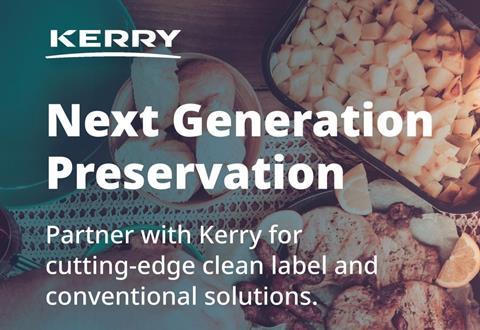Kerry explains why acetates are coming to the fore in meat preservation. Behind the shift: clear cost savings, efficacy at much lower doses with a dry product, a push to reduce salt consumption and continuous disruptions in lactic acid supply and pricing.

The ongoing fear of pathogenic contamination as a threat to human health keeps meat products at the top of consumers’ minds whenever the subject of food safety arises. Fortunately, the risk can be controlled with proper food safety hurdles and preservation ingredients in place.
Lactic and acetic acid (and the neutralised salts of these organic acids) are time-tested meat safety and shelf-life extension solutions. Of these, sodium lactate - based on lactic acid - is most used in the marketplace today and adds a light, tasty, now familiar salty flavour. The downside is that it contributes sodium to the final end product.
Acetate-based preservatives - derived from acetic acid - are an option now receiving serious consideration. Acetates offer several important competitive advantages over lactates: lower cost in use, low or zero sodium content, excellent antimicrobial properties against pathogens, no unwanted taste impacts and reliability of supply.
Cost-in-use benefits: acetates effective at up to five times lower dosage than lactates
Acetates are effective at controlling bacterial threats at the same pH level at five to seven times lower dosage than lactates. This is due to a higher undissociated acid content, and results in several key benefits: less preservation product needed for better sensory and nutritionals, competitive cost, efficacy at low dosages and a confirmed ability to meet vital food safety standards.
You will notice that many lactate-based products today are lactate-diacetate blends as the industry has long-since recognised the benefits of adding an acetate-based addition to their solution.
Regulators focus on salt: sodium now in the crosshairs
Sodium-based preservatives make up over 84% of retail meat new product development (Innova Market Insights) in Europe, but sodium levels in meat are coming under increasing scrutiny from consumers and food regulators alike.
Reducing sodium is a worthy investment but can create challenges when formulating for shelf life, and these must not be ignored. For the meat industry, the race has begun to uncover next generation solutions that will replace sodium’s role in the protection, preservation and flavour of meat without negatively impacting the lifespan of products. However, formulating for success with new preservation solutions can take time across application studies and challenge tests. An established preservation partner can expedite this with libraries of data, models and application support but it is vital for meat processors to initiate the process without delay.
Whether it’s through lowering the contribution with a fractional dosage of sodium acetate/diacetate or investing in innovative zero-sodium potassium acetate/diacetate solutions, there’s no doubt that the switch to acetates can greatly assist in the effort.

Lactic acid supply-chain challenges
With its versatility, food-grade lactic acid is one of those ingredients for which global demand has outstripped supply. In addition to its food protection role, lactic acid is used in a wide range of other industries and applications, including pharma, bioplastics and other uses that emerged during the pandemic. For meat processors, the supply challenges around lactic acid should be of strong concern when it and its derivatives - such as lactates - are the products being used to control pathogenic bacteria in meat.
Decreasing reliance on lactic acid will save meat processors time and money as they address the booming call to reduce sodium content.
Provian® K builds on the proven protective power of acetates, demonstrating measurable benefits over other conventional preservatives. Couple this with its easy-to-handle, free-flowing dry formulation, and you are working with next generation preservation.















